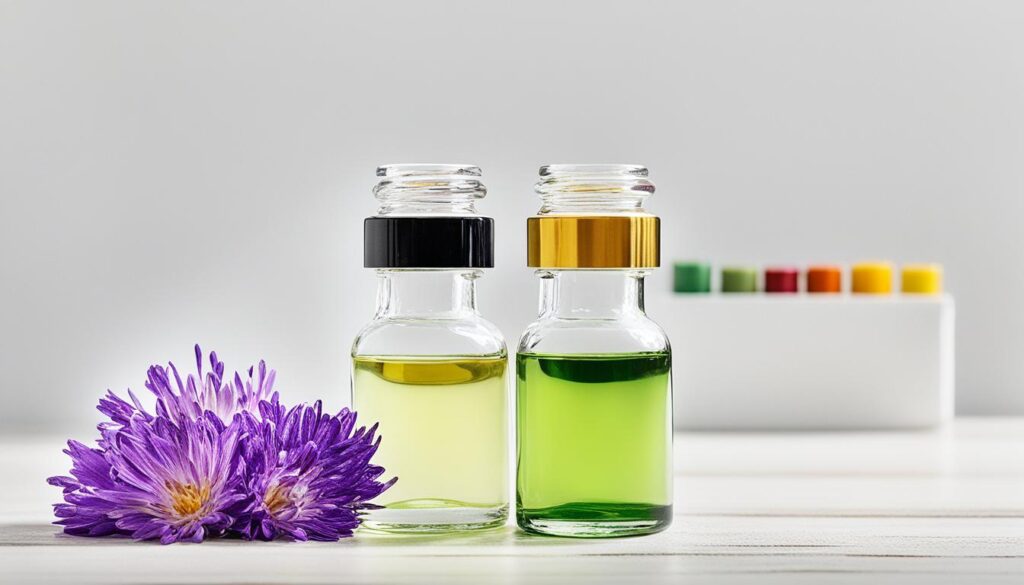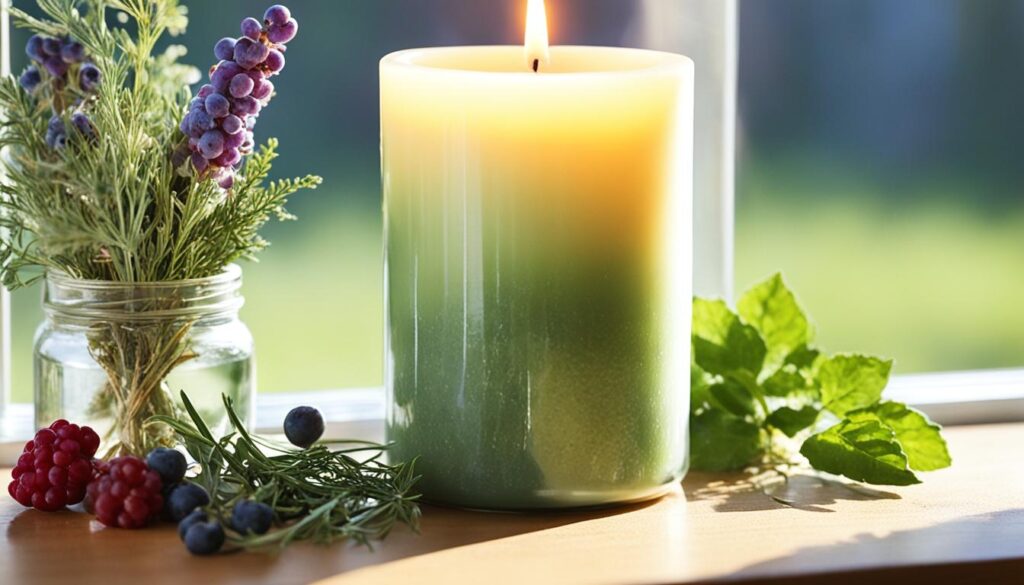Easy Ways to Increase the Scent Throw of Your DIY Candles
Are you upset that your homemade candles don’t fill the room with their scent? You’re not alone. Many candle lovers find it hard to get the perfect “scent throw.” This is the ability of a candle to spread its smell around the room.
But don’t worry, with a few easy tips, you can make your DIY candles amazing. They will fill your space with wonderful smells and impress everyone. We’ll show you how to make your candles smell better, from the science behind it to simple tips.
If you’re new to candle making or have been doing it for a while, this guide is for you. We’ll share the best waxes for strong smells and how much fragrance to use. Get ready to improve your candle-making and wow your friends and family with your new skills.
What is Scent Throw?
In candle making, “scent throw” is a big deal. It’s about how strong and intense a candle’s smell is. It’s what makes a candle truly special and memorable. Getting scent throw right is key to making candles that fill a room with your favorite smells.
Hot Throw and Cold Throw Explained
There are two kinds of scent throw: hot and cold. Hot throw is the smell when the candle is lit. Cold throw is the smell of the candle when it’s not lit. Knowing the difference is important for making the perfect candle.
A strong hot throw means your candle smells great when it’s burning. A strong cold throw means it smells good even when it’s not lit. Finding the right balance between hot and cold throw makes your candles stand out.
| Hot Throw | Cold Throw |
|---|---|
| Strength of fragrance when the candle is lit and burning | Fragrance strength of the unlit candle |
| Determines how strongly the candle will scent a room | Ensures the candle still emits a pleasant aroma when unlit |
| Key to creating a captivating candle experience | Helps entice potential buyers or guests |
“Mastering the balance between hot and cold throw is the key to creating candles that captivate the senses from the moment they’re lit to when they’re simply sitting on a shelf or table.”
Common Reasons for Weak Scent Throw
If your homemade candles don’t smell as strong as you’d like, there could be a few reasons. The quality of the fragrance oil, how much you use, and how you mix it with the wax matter a lot. Finding out what’s causing the weak scent is the first step to fixing it and making your candles smell better.
One big reason your candles might not smell strong is the fragrance oil quality. Using low-quality or diluted oils can lead to a weak scent. Choosing high-quality, concentrated oils can greatly improve your candles’ scent.
Another issue is the fragrance load, or how much oil you add to the wax. If you don’t use enough, your candle won’t have a strong smell. Trying different amounts of oil can help you find the right balance.
How you mix the fragrance into the wax also affects the scent. Making sure the fragrance is well-blended and spread out can help it smell better.
| Reason | Description |
|---|---|
| Fragrance Oil Quality | Low-quality or diluted fragrance oils may not provide the desired scent intensity. |
| Fragrance Load | If the fragrance load (amount of fragrance added) is too low, the candle may not release a strong enough scent. |
| Fragrance Incorporation | The way the fragrance is blended and distributed throughout the wax can affect the scent throw. |
By fixing these common problems, you can make your DIY candles smell better. This way, they’ll fill the room with a lovely scent.
Fragrance Oil Quality Matters
When making DIY candles, the quality of the fragrance oils is key. It greatly affects the strength and longevity of the scent. Choosing high-quality fragrance oils made for candle making is essential. This ensures your candles give a scent that pleases the senses.
Stay away from low-quality, cheaper fragrance oils. They often don’t have the right mix to give a strong scent in candles. These oils can lead to a weak, short-lasting smell that doesn’t impress. Look for reputable fragrance oil suppliers. They offer best fragrance oils for candle making that are made to give a strong, lasting scent.
“The right fragrance oil can elevate a good candle into an exceptional one, filling the room with a delightful aroma that lingers long after the flame is extinguished.”
Choosing high quality fragrance oils for strong scent is a smart move for DIY candle making. By getting them from trusted reputable fragrance oil suppliers, your candles will have a scent that really connects with people. It will make a memorable impact on your audience.
Adjusting Fragrance Load
Creating scented candles means knowing how much fragrance oil to use. Adding too much can cause problems like sweaty candle tops and fire hazards. Most waxes work best with 6-12% fragrance oil.
Finding the Sweet Spot for Your Candles
Trying different amounts of fragrance is key to finding what works best for your candles. This might take some trial and error. But, it’s worth it to get the perfect how much fragrance to add to candles and the ideal fragrance load for strong scent.
To find your ideal candle fragrance load guide, follow these tips:
- Begin with a 6% fragrance load and increase it by 2% at a time until you get the scent you want.
- Watch for sweating or frosting as you add more fragrance. This means you might be using too much.
- Sniff your candle at different burn stages to check the scent strength and how long it lasts.
- Keep track of the fragrance loads you try and how they affect the scent. This will help you in the future.
Finding the right fragrance balance lets you make DIY candles with a strong, lasting scent. This will make your candles a hit with everyone who tries them.
Fragrances Smell Different in Wax
When making your own DIY candles, remember that fragrances can smell different in wax than they do in the bottle. The way the fragrance mixes with the wax changes the final scent. This can lead to surprises. Before buying a lot of fragrance, test small batches to see how it smells in your wax.
Testing fragrances for candle making is key to getting the scent you want. This step helps you make smart choices and avoid bad surprises with how fragrances work in wax.
“The scent throw of a candle is greatly influenced by the interaction between the fragrance and the wax. That’s why it’s so important to test out your fragrances before committing to a large batch.”
Testing your fragrances in small batches lets you adjust the amount used. This ensures your candles smell just right. It helps make candles that your customers will enjoy.
Creating the perfect scented candle is about knowing how fragrances work in wax. With some testing and focus on details, you can make candles that fill the room with lovely scents.
Using Essential Oils vs Fragrance Oils
When making scented candles, you can choose between essential oils and fragrance oils. Essential oils are natural but might not give the same strong scent as fragrance oils. Fragrance oils are made to fill the air with a powerful smell, making them a top pick for a strong scent.
Some fragrance oils mix essential oils with synthetic ones. This blend offers a natural scent but with a strong aroma. It’s a good choice for those who want a candle with a deep, lasting scent.
| Essential Oils | Fragrance Oils |
|---|---|
| Derived from natural plant sources | Synthetic, man-made compounds |
| Offer a more natural scent profile | Designed for maximum scent throw |
| May not provide as strong a scent throw | Typically offer a stronger, more consistent scent |
| Can be more expensive | Generally more cost-effective |
If you want candles with a powerful scent, go for fragrance oils. For a natural candle scent, essential oils are a good choice. The choice between essential and fragrance oils depends on what scent you like and what you’re making.
“Fragrance oils are specifically formulated to deliver a strong, consistent aroma in candles, often outperforming essential oils in terms of scent throw.”

Adding Fragrance at the Right Temperature
When making scented candles, adding fragrance oil at the right temperature is key. It affects the aroma and how well the scent fills the room. Fragrance oils must mix well with the wax to create the perfect scent.
Optimal Temperatures for Different Waxes
For soy wax candles, add fragrance oil at about 185°F. This ensures the scent spreads evenly with the wax. Coconut wax, however, needs a higher temperature, over 200°F, for a strong scent.
Always mix the fragrance and wax well together. This step is vital for a strong scent that lasts. If you skip this step, your candle might not smell as good.
“The temperature at which you add fragrance oil to your candle wax can significantly impact the scent throw. Fragrance oils need to properly bind with the wax to achieve the desired aroma.”
Pay attention to when and how you add fragrance oil to your wax. This knowledge helps bring out the best in your homemade candles. Following these tips will make your candles more inviting.
make scented candles smell stronger
Do you want candles that make your home smell amazing? You can make your homemade candles smell better with a few easy steps. Start by using top-quality fragrance oils made just for candle making. Try different amounts of fragrance to find the best mix for scent and wax.
Also, watch the temperature when you add the fragrance. Different waxes like paraffin, soy, or beeswax work best at certain temperatures. Getting this right can greatly improve your candle’s scent.
The wax type also affects how strong the scent is. Paraffin wax is known for its strong smell, but soy and beeswax can be great too if you do it right. Make sure to cure your candles well. This lets the scent fully come out and spread.
| Technique | Impact on Scent Throw |
|---|---|
| Using high-quality fragrance oils | Enhances the overall scent strength |
| Adjusting fragrance load | Finds the optimal balance for your candles |
| Incorporating fragrance at the right temperature | Ensures the fragrance is properly dispersed in the wax |
| Choosing the right wax type | Paraffin offers stronger scent throw, but soy and beeswax can also perform well |
| Properly curing your candles | Allows the fragrance to fully develop and release its aroma |
By using these candle making techniques for better scent, you can make candles that really grab your attention. Try new things, have fun, and show off your creativity with your scented candles.

The Impact of Wax Type
Choosing the right wax for strong-scented candles is key. Paraffin wax is a top choice for strong scents. Its structure lets fragrances come out well, making it a favorite for candle makers.
Soy wax is also good but can hold back the scent throw. Yet, with the right methods, it can still give great scents. Blended waxes with a bit of paraffin are also great for improving scent throw.
Exploring Wax Comparisons
When looking at candle wax types for scent, each has its own traits. Paraffin wax is top for strong scents. Soy wax might need extra effort for good scents. Blended waxes offer a good mix, giving a middle ground for scent.
| Wax Type | Scent Throw Performance | Pros | Cons |
|---|---|---|---|
| Paraffin Wax | Excellent |
|
|
| Soy Wax | Good |
|
|
| Blended Wax | Very Good |
|
|
The choice of wax greatly affects the strength and performance of the scent throw. Knowing each wax’s traits helps you pick the best for your candles. This way, you can create the best-scented candles for your needs.
Importance of Curing Your Candles
Curing your DIY candles is key to making them smell great. After you pour the wax, it hardens and changes into a crystalline structure. This process lets the fragrance fully develop and stick to the wax. This makes the scent stronger and lasts longer.
Recommended Curing Times
The time you should cure your candles depends on the wax type. Paraffin and soy wax candles need at least one week to cure. Coconut wax candles need two weeks. It’s important to cure your candles well for the best scent.
Not curing your candles or rushing it can make the scent weak. Taking the time to cure them fully gives you a candle with a strong, inviting fragrance. This will make your candles more enjoyable for you and your guests.
| Wax Type | Recommended Curing Time |
|---|---|
| Paraffin | Minimum 1 week |
| Soy | Minimum 1 week |
| Coconut | Minimum 2 weeks |
The curing process is vital for your DIY candles’ full potential. By following these guidelines, you’ll make candles with a great scent that lasts.

Vessel Size and Dimensions
Creating DIY candles can be fun, and the size of your candle vessel matters. It’s not the biggest factor, but it still affects how well your candle smells. The shape and size of the vessel can change how much fragrance your candle releases.
Candles in wider containers often smell stronger than tall, narrow ones. This is because they let more fragrance out. But remember, other things like the wick and wax type can change this.
To make your candle smell better, think about these tips for choosing containers:
- Choose wider, shallower vessels for a bigger melt pool and stronger scent.
- Stay away from tall or narrow containers, as they can reduce the fragrance.
- Try different sizes and shapes to see what works best for your candle and scent.
The size and shape of your candle vessel can help with the scent. But it’s not the only thing that matters. The type of wax, how much fragrance you use, and how long you cure the candle also affect the smell.
Conclusion
There are many ways to make your homemade candles smell better. Start by using high-quality fragrance oils. Adjust how much fragrance you add and mix it into the wax at the right temperature. This will help create strong scents that fill your home.
Think about the type of wax you use and let your candles cure. These steps can make the scent even stronger.
To make your DIY candles smell amazing, remember a few key things. Use top-quality fragrance oils and play with how much you add. Make sure to mix the fragrance into the wax at the best temperature for the wax type.
With these tips, you can improve your candle-making skills. You’ll make candles with scents that last a long time and make you happy.
When you start making more DIY candles, keep these tips in mind. They will help you make candles with great fragrances. By following these steps, you’ll get better at making candles that have wonderful smells.
FAQ
What is scent throw in candles?
Why are my homemade candles not producing a strong enough scent?
How does the quality of the fragrance oil affect scent throw?
What is the optimal fragrance load for strong scented candles?
How does the wax type affect the scent throw of candles?
Why is curing my candles important for scent throw?
Does the size and shape of the candle vessel affect scent throw?
Source Links
- How to Improve Scent Throw & Make Your Candles Smell Strong – https://northwoodcandlesupply.com/blogs/news/how-to-improve-candle-scent-throw?srsltid=AfmBOorBa7pj4drgQIMUku_ASzaZL4UcJuGxSsHO3vi4MZ6RpEaL0IMr
- Candle Making 101: Hot Throw – https://www.candlescience.com/learning/candle-making-101-hot-throw/?srsltid=AfmBOoqn_-BmdxWKCdCNdrowgOJmUVA7iW4FzYnwaFbv_2pN1wMzPtZg
- Can’t get decent scent throw from fragrance or essential oils! – https://www.soapmakingforum.com/threads/cant-get-decent-scent-throw-from-fragrance-or-essential-oils.85030/
- Fragrance That Wows: A Beginner’s Guide to Adding Scents to Your Homemade Candles
- best essential oils for candles
- wood wick guide
- how to make candles smell stronger
- how to ship candles
- how to fix soy wax frosting
- wick Guide how to choose the right wick size with chart
- how to make candle molds
- how to clean candle wax
- how to reuse candle jars
- soy wax candle troubleshooting
- best wax melter for candle making
- how to conduct burn test
- why candle flickering crackling smoking
- how much wax per candle
- how to make candles smell stronger
- Easy Ways to Increase the Scent Throw of Your DIY Candles
- How to Make Candles for Meditation and Relaxation
- Using Upcycled Materials in Candle Making
- How to Make Hand-Poured Candles: Tips and Techniques

Leave a Reply